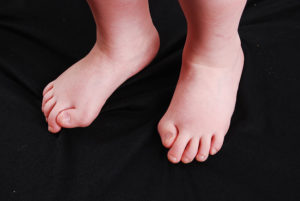Malformed big toes (short, bent and sometimes curved inward) are nearly always associated with Fibrodysplasia Ossificans Progressiva and can be observed at birth. The big toe is actually missing the last joint before the end of the toe. These toes cause few problems but serve as a crucial early sign of FOP before the onset of extra bone. Some children may also have shorter thumbs than usual, and may also have reduced range of motion in their necks. Otherwise, nothing may appear to be out of the ordinary until the child begins having swellings in the muscles, tendons and ligaments. Some variations of FOP are not associated with malformed toes.
Although the condition is congenital (meaning it starts before birth) extra bone does not form before birth.
Symptoms of progressive extra bone formation usually begin during the first two decades of life. FOP often begins in the neck and shoulders and progresses along the back, trunk and limbs of the body.
Rather than crawl on their hands and knees, many kids with FOP scoot on their bottoms, then get up and walk. This is due to facet joints in the back of their necks either not properly forming or fusing thus limiting movement.
Inflamed (and often painful) swellings, typically in the shoulder and back areas, or on the head, are usually the first signs of FOP. The swelling of a ‘flare up’ eventually settles, but leaves behind a new piece of mature bone. A lump is usually the first sign of FOP, but unfortunately FOP is so rare that most doctors are unaware of the condition and look to more common possible diagnoses (eg cancer, aggressive juvenile fibromatosis). In the process, catastrophic damage can result from intramuscular injections, biopsies and surgery. Invasive procedures such as these are contraindicated in FOP.
Rates of bone formation differ greatly among those with FOP. Therefore the age at diagnosis and rate of progression is variable and hard to predict. Flare-ups can be random or as a result of trauma to the body from falls, strains, knocks, intramuscular injections (including intramuscular immunisations) and dental procedures or surgery. Influenza can also trigger a flare-up. However, extra bone formation tends to occur in the neck, shoulders and upper back early in life and in the hips and knees during adolescence or early adulthood.
You can learn more about the clinical features of FOP by watching the Clinical Features video.
If you think you or your child may have FOP, FOP Australia may be able to help you Find a Health Professional familiar with FOP. The International Clinical Council on FOP have published consensus statements on management of FOP to assist your health professionals in helping you – use the link at the top of every page of this website to view these guidelines.
Much remains unknown about the natural history of FOP. Involvement of clinicians and patients in the FOP Registry is vital to help this condition be better understood, and hopefully recognised and diagnosed earlier.

